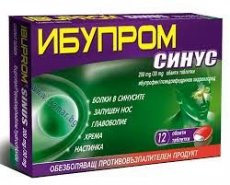Medical expert of the article
New publications
Preparations
Ibuprom sinus
Last reviewed: 03.07.2025

All iLive content is medically reviewed or fact checked to ensure as much factual accuracy as possible.
We have strict sourcing guidelines and only link to reputable media sites, academic research institutions and, whenever possible, medically peer reviewed studies. Note that the numbers in parentheses ([1], [2], etc.) are clickable links to these studies.
If you feel that any of our content is inaccurate, out-of-date, or otherwise questionable, please select it and press Ctrl + Enter.

Ibuprom sinus is a combination drug that has analgesic, anti-inflammatory and antipyretic effects, and also reduces swelling of the mucous membrane of the nasal cavity and paranasal sinuses. Synonym - Ibuprom sprint caps.
Indications Ibuprom sinus
This drug is intended for short-term symptomatic treatment of colds, acute respiratory infections and flu, accompanied by headache, sore throat, muscle pain (myalgia), fever, inflammation of the nasal mucosa and paranasal sinuses and rhinitis.
 [ 1 ]
[ 1 ]
Pharmacodynamics
The pharmacodynamics of Ibuprom sinus is associated with the blocking of the cyclooxygenase enzyme by ibuprofen (a non-steroidal anti-inflammatory drug, a derivative of isobutylphenylpropionic acid), which leads to a reduction in the synthesis of prostaglandins - lipid mediators of pain, inflammation and temperature response of the body.
Pseudoephedrine in the form of hydrochloride stimulates alpha- and beta-adrenergic receptors of small vessels of the mucous membrane of the respiratory tract, which leads to their narrowing. As a result, vascular permeability and swelling of the mucous tissues of the nasal cavity decrease, patency of the nasal passages increases, discharge from the paranasal sinuses improves, and breathing through the nose is restored.
Pharmacokinetics
After oral administration, Ibuprom sinus is absorbed in the gastrointestinal tract and enters the bloodstream, the therapeutic effect is felt on average 20-25 minutes after taking the drug, and its duration is from 4 to 6 hours.
The maximum concentration of ibuprofen in blood plasma is observed 1-2 hours after administration. The drug is metabolized in the liver, the excretion of metabolites is carried out by the kidneys (with urine); about 1% of ibuprofen and 55-75% of pseudoephedrine are eliminated from the body unchanged.
Use Ibuprom sinus during pregnancy
The use of Ibuprom sinus during pregnancy and lactation is contraindicated.
Contraindications
Contraindications to the use of Ibuprom sinus include:
- individual hypersensitivity to the components included in the drug;
- acetylsalicylic acid intolerance;
- history of tendency to allergic reactions;
- bronchial asthma;
- gastric ulcer and duodenal ulcer in the acute stage;
- history of gastric bleeding;
- acute renal or hepatic failure;
- serious disorders of the cardiovascular system;
- angle-closure glaucoma;
- diabetes mellitus;
- elevated levels of thyroid hormones (hyperthyroidism);
- pheochromocytoma (a tumor of the adrenal tissue);
- hyperplasia (adenoma) of the prostate gland;
- age up to 12 years.
While taking this medicine, you should be careful when driving vehicles and operating machinery.
Side effects Ibuprom sinus
The most common side effects of Ibuprom sinus are:
- headaches and dizziness;
- skin rashes in the form of hives, itchy skin;
- heartburn, pain in the epigastric region, nausea, vomiting, dyspepsia;
- shortness of breath, increased heart rate, increased blood pressure;
- increased excitability, sleep disturbances;
- dysuria (urinary retention), edema;
- loss of appetite;
- hyperhidrosis (excessive sweating).
Overdose
Overdose of this drug causes nausea and vomiting, headache and stomach pain, drowsiness, tinnitus, and heart rhythm disturbances. A significant overdose exceeding 400 mg/kg of body weight may lead to atrial fibrillation, a drop in blood pressure, hyperthermia, increased acidity (acidosis), and respiratory failure leading to a comatose state.
Long-term use of Ibuprom sinus can cause pathological changes in the blood: increased breakdown of red blood cells (hemolytic anemia), a decrease in the number of granulocytes (granulocytopenia), and a decrease in the level of platelets (thrombocytopenia).
In cases where acute signs of overdose appear within 1 hour of taking the drug, induce vomiting, wash out the stomach or take activated charcoal. Treatment of the consequences of overdose is symptomatic.
Interactions with other drugs
The key interactions of Ibuprom sinus with other drugs are that its use excludes the use of other non-steroidal anti-inflammatory drugs (NSAIDs) and acetylsalicylic acid (aspirin) - due to the risk of increased side effects.
Ibuprom sinus reduces the therapeutic effect of some hypotensive and thiazide diuretics. When used simultaneously with drugs of the coumarin anticoagulant group, which reduce blood clotting, their effect is enhanced.
Ibuprom sinus increases the level of toxicity of the antitumor cytostatic drug methotrexate. When combined with digitalis drugs, it can cause cardiac arrhythmia; with drugs containing corticosteroid hormones, it increases the risk of gastrointestinal bleeding;
Taking Ibuprom sinus and lithium preparations used in psychiatry (psychotropic drugs) leads to an increase in the concentration of lithium in the blood and the occurrence of its side effects.
Attention!
To simplify the perception of information, this instruction for use of the drug "Ibuprom sinus" translated and presented in a special form on the basis of the official instructions for medical use of the drug. Before use read the annotation that came directly to medicines.
Description provided for informational purposes and is not a guide to self-healing. The need for this drug, the purpose of the treatment regimen, methods and dose of the drug is determined solely by the attending physician. Self-medication is dangerous for your health.

